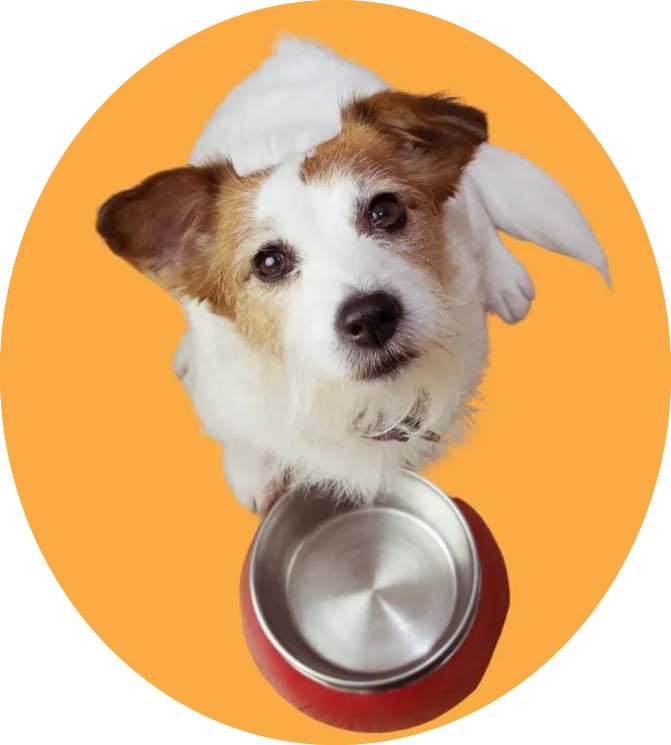- Home
- Dog Wellness
- How Quickly Do Dogs Adapt to New Pet Food?
3 min read
How Quickly Do Dogs Adapt to New Pet Food?
By Tim Falk
Published: 02/16/2021, edited: 06/14/2024
Save on pet insurance for your pet
You don't have to choose between your pet and your wallet when it comes to expensive vet visits. Prepare ahead of time for unexpected vet bills by finding the pawfect pet insurance.
Changing your dog’s food is a big step to take. The food you choose needs to provide a complete and balanced diet for your pooch, so it’s not a decision you should make lightly.
But if you’ve found a better diet for your dog, you’ll also need to take special care to help them adjust to their new food.
But how long does it take dogs to adjust to a new food? And what can you do to make the transition easier? Keep reading to find out.
Why you should switch your dog to a new food
Why would you want to feed your dog a different diet? What’s the point of switching foods?
There are actually several important reasons why you may need to transition your fur-baby to a new food, such as:
You want to feed a higher-quality food to your dog
Your pet has a food allergy or is sensitive to a particular ingredient
Your dog needs to lose or gain weight
It’s time for your puppy to switch to adult dog food
You’re welcoming a new puppy or adopting a dog
You want to switch from dry to wet food to give your pet more variety
Your pet needs to switch to a special diet on the advice of your veterinarian
Prescription dog food can be expensive.
Many pet insurance plans cover the cost of prescription food. Invest in pet insurance today and save over $270 a year on vet care costs.
The trouble with switching
Some dogs will switch to a new food with no hassles at all. But for many dogs, introducing them to a new diet can result in an upset stomach. We’re talking diarrhea, vomiting, and other digestive symptoms, all of which can be quite unpleasant for your dog and quite worrying for you.
So instead of abruptly cutting off their old diet and feeding their new one, it’s important to make the change gradually so your dog has a chance to adapt.
How to transition your dog to a new food
As a general guide, it’s recommended to transition your dog to a new food over a period of approximately one week. For pups with especially sensitive stomachs, a slightly longer transition may help minimize the risk of tummy troubles.
The trick is to mix your dog’s new food in with their old food. Start by replacing a small amount of your dog’s food with the new food, and then gradually increase the amount of new food (and decrease the amount of old food) you give them.
The ratios should look something like this:
Days 1 to 2: 25% new food and 75% old food
Days 3 to 4: 50% new food and 50% old food
Days 5 to 6: 75% new food and 25% old food
Day 7: 100% new food
This approach should hopefully ensure a seamless transition to the new diet. However, it’s important to watch your dog closely so you can monitor how they respond to the food change.
Signs and symptoms as your dog adjusts
It’s important to keep a close eye on your dog to check how they’re adapting to the new food. Some of the symptoms to keep an eye out for include:
Vomiting
Diarrhea
Constipation
Loss of appetite
While it may be an unpleasant task, it’s also important to monitor your dog’s stool. If you notice that your pup’s poop is softer than normal or even runny, switching diets could be causing some tummy troubles. If that’s the case, you can slow down the transition process to give your pet’s stomach a little more time to adapt.
Of course, it’s worth mentioning that there are plenty of other potential causes of an upset stomach. For example, if you’ve just brought home a new dog, their tummy troubles could be a result of the inevitable anxiety that comes with adjusting to life in a new home.
How to tell if a new diet is working
If all goes well, by the end of the transition period, your pooch will have completely switched to their new food without encountering any major issues. But how do you know if the new diet is having the desired effect and offering all the nutrition your dog needs?
Once your dog has been eating their new food for a couple of months, you’ll be better placed to see how they’re responding to the dietary change. And the best way to make this assessment is to look at your dog.
Do they look happy and healthy? Are they in the right weight range? Does their coat look shiny and glossy? Do they have plenty of energy?
You can also check your pet for any signs that they may be having issues with the new food, such as skin irritations or continuing digestive problems. And if there are any signs that the new diet may not be producing the desired results, schedule an appointment with your vet so you can find out what to do next.
A high-quality diet is essential for keeping your dog happy and healthy. Digestive problems and food allergies can be expensive to treat. Compare pet health insurance plans to save more than $270 a year on vet care.
You may also like
